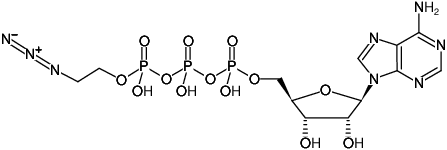γ-(2-Azidoethyl)-adenosine-5'-triphosphate, Sodium salt
| Cat. No. | Amount | Price (EUR) | Buy / Note |
|---|---|---|---|
| NU-1701S | 100 μl (10 mM) | 150,10 | Add to Basket/Quote Add to Notepad |
| NU-1701L | 5 x 100 μl (10 mM) | 439,50 | Add to Basket/Quote Add to Notepad |

For general laboratory use.
Shipping: shipped on gel packs
Storage Conditions: store at -20 °C
Short term exposure (up to 1 week cumulative) to ambient temperature possible.
Shelf Life: 12 months after date of delivery
Molecular Formula: C12H19N8O13P3 (free acid)
Molecular Weight: 576.25 g/mol (free acid)
Exact Mass: 576.03 g/mol (free acid)
Purity: ≥ 95 % (HPLC)
Form: solution in water
Color: colorless to slightly yellow
Concentration: 10 mM - 11 mM
pH: 7.5 ±0.5
Spectroscopic Properties: λmax 259 nm, ε 15.3 L mmol-1 cm-1 (Tris-HCl pH 7.5)
Applications:
in vitro phosphorylation of recombinant proteins[1]
Description:
Lee et al.[1] reported a non-radioactive version of in vitro phosphorylation were γ-[2-Azidoethyl]-ATP (compound 8[1]) has been successfully used instead of γ-32P-modified ATP to phosphorylate GST-tagged recombinant p27kip1 with protein kinase cdk2.
The phosphorylated, azide-modified protein substrate can subsequently be labeled with Alkynes of biotin or fluorescent dyes via Cu(I)- catalyzed Click-Chemistry or DBCO-containing biotin or fluorescent dyes via Cu(I)-free Click-Chemistry.
Presolski et al.[2] and Hong et al.[3] provide a general protocol for Cu(I)-catalyzed click chemistry reactions that may be used as a starting point for the set up and optimization of individual assays.
Related products:
BIOZ Product Citations:
Selected References:
[1] Lee et al. (2009) Synthesis and reactivity of novel γ-phosphate modified ATP analogues. Bioorg Med Chem Lett. 19:3804.
[2] Presolski et al. (2011) Copper-Catalyzed Azide-Alkyne Click Chemistry for Bioconjugation. Current Protocols in Chemical Biology 3:153.
[3] Hong et al. (2011) Analysis and Optimization of Copper-Catalyzed Azide-Alkyne Cycloaddition for Bioconjugation. Angew. Chem. Int. Ed. 48:9879.